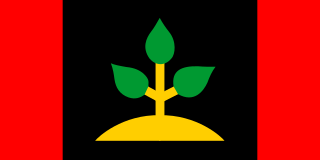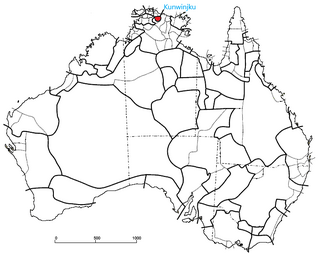
The Awabakal people, are those Aboriginal Australians who identify with or are descended from the Awabakal tribe and its clans, Indigenous to the coastal area of what is now known as the Hunter Region of New South Wales. Their traditional territory spread from Wollombi in the west, to the Lower Hunter River near Newcastle and Lake Macquarie in the north.
The Adnyamathanha are a contemporarily formed grouping of several distinct Aboriginal Australian peoples of the northern Flinders Ranges, South Australia. The ethnonym Adnyamathanha was an alternative name for the Wailpi but the contemporary grouping also includes the Guyani, Jadliaura, Pilatapa and sometimes the Barngarla peoples. The origin of the name is in the words "adnya" ("rock") and "matha".

The Larrakia people are a group of Aboriginal Australian people in and around Darwin in the Northern Territory. The Larrakia, who refer to themselves as "Saltwater People", had a vibrant traditional society based on a close relationship with the sea and trade with neighbouring groups such as the Tiwi, Wadjiginy and Djerimanga. These groups shared ceremonies and songlines, and intermarried.
The Wardaman people are a small group of Aboriginal Australians living about 145 kilometres (90 mi) South-West of Katherine, on Menngen Aboriginal Land Trust in the Northern Territory of Australia.
The Burarra people, also referred to as the Gidjingali, are an Aboriginal Australian people in and around Maningrida, in the heart of Arnhem Land in the Northern Territory. Opinions have differed as to whether the two names represent different tribal realities, with the Gidjingali treated as the same as, or as a subgroup of the Burarra, or as an independent tribal grouping. For the purposes of this encyclopedia, the two are registered differently, though the ethnographic materials on both may overlap with each other.

The Kunwinjku people are an Australian Aboriginal people, one of several groups within the Bininj people, who live around West Arnhem Land to the east of Darwin, Northern Territory. Kunwinjku people generally refer to themselves as "Bininj" in much the same way that Yolŋu people refer to themselves as "Yolŋu".

The Nyikina people are an Aboriginal Australian people of the Kimberley region of Western Australia.
Wanggamala, also spelt Wanggamanha, Wangkamahdla, Wangkamadla, Wangkamanha, Wangkamana, Wonkamala, Wongkamala, Wonkamudla, and other variants, is an extinct Australian Aboriginal language of the Pama–Nyungan family, previously spoken in the Northern Territory around Hay River and to the south of the Andegerebinha-speaking area.
The Kaiadilt are an Aboriginal Australian people of the South Wellesley group in the Gulf of Carpentaria, Queensland, Australia. They are native to Bentinck Island, but also made nomadic fishing and hunting forays to both Sweers and Allen Islands. Most Kaiadilt people now live on Mornington Island.
The Waanyi people, also spelt Wanyi, Wanji, or Waanji, are an Aboriginal Australian people from south of the Gulf of Carpentaria in Queensland and the Northern Territory.
The Gajirrawoong people, also written Gadjerong, Gajerrong and other variations, are an Aboriginal Australian people of the Northern Territory, most of whom now live in north-eastern Western Australia.
The Yangman were an indigenous Australian people of the Northern Territory.
The Nungali, otherwise known as the Ilngali, are an Indigenous Australian people of the Northern Territory.
The Ngaliwurru are an indigenous Australian people of the Northern Territory.
The Panyjima, also known as the Pandjima/Banjima, are an Aboriginal Australian people of the Pilbara region of Western Australia.
The Buruna, also known as the Punduna, are an Aboriginal Australian people of the Mid West region of Western Australia.
The Doolboong, also known as Duulngari, were an Aboriginal Australian people of the Northern Territory and northeast Western Australia.
The Iwaidja are an Indigenous Australian people of the Northern Territory.
The Ngarnka, also Ngarnji or Ngewin, are an indigenous Australian people of the Northern Territory. They are often said to be the same as the Gudanji, one of whose alternative names is Ngarnji. However linguists distinguish between the language spoken by Ngarnka speakers and those who speak Gudanji.
The Jingili or Jingulu are an indigenous Australian people of the Northern Territory.